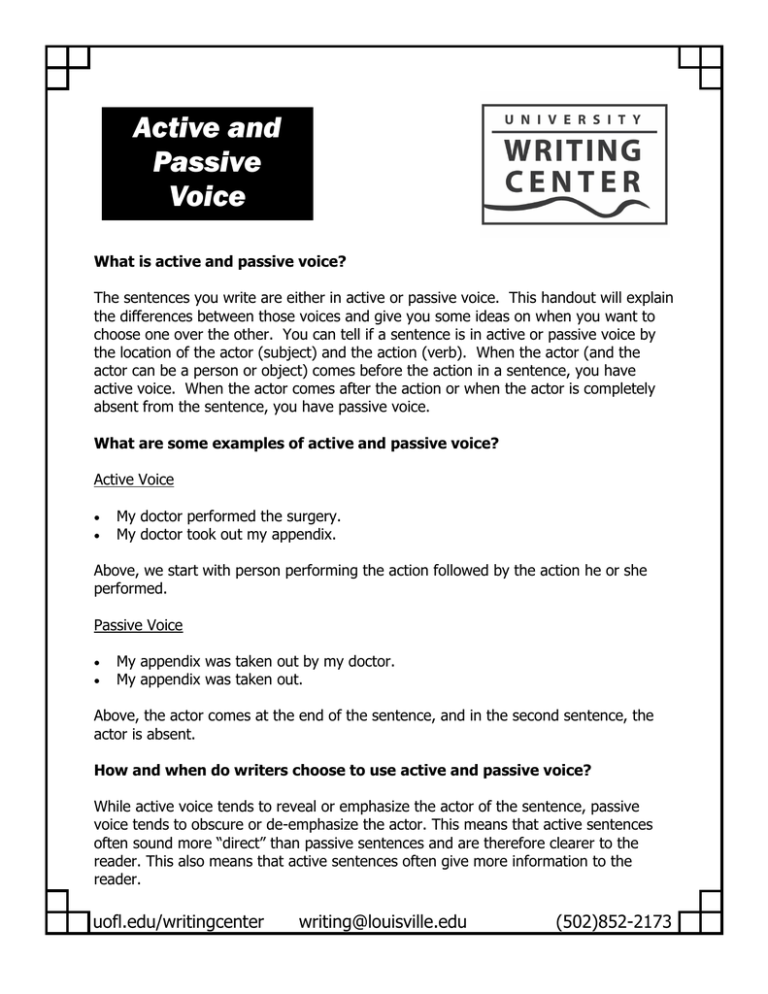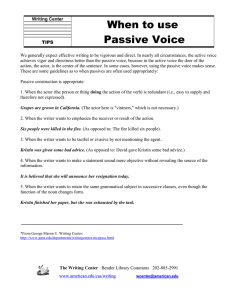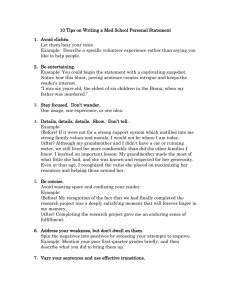Active and Passive Voice
advertisement

Active and Passive Voice What is active and passive voice? The sentences you write are either in active or passive voice. This handout will explain the differences between those voices and give you some ideas on when you want to choose one over the other. You can tell if a sentence is in active or passive voice by the location of the actor (subject) and the action (verb). When the actor (and the actor can be a person or object) comes before the action in a sentence, you have active voice. When the actor comes after the action or when the actor is completely absent from the sentence, you have passive voice. What are some examples of active and passive voice? Active Voice My doctor performed the surgery. My doctor took out my appendix. Above, we start with person performing the action followed by the action he or she performed. Passive Voice My appendix was taken out by my doctor. My appendix was taken out. Above, the actor comes at the end of the sentence, and in the second sentence, the actor is absent. How and when do writers choose to use active and passive voice? While active voice tends to reveal or emphasize the actor of the sentence, passive voice tends to obscure or de-emphasize the actor. This means that active sentences often sound more “direct” than passive sentences and are therefore clearer to the reader. This also means that active sentences often give more information to the reader. uofl.edu/writingcenter writing@louisville.edu (502)852-2173 Active and Passive Voice Many writers are told to avoid using passive voice. This might be because passive voice is sometimes seen as weak or unconfident. It might also be because passive voice is sometimes used to hide an action’s cause or actor from the reader. However, passive voice is very useful when you need to emphasize the effects of an action, rather than its cause or its actor. In fact, it’s required for certain types of scientific writing, because it emphasizes the processes and results of research, rather than the choices or biases of the scientists. How can writers edit for active and passive voice? If you need to make your sentences more active (for example, if you’re having trouble showing cause-and-effect) you can look for sentences that use “to be” verbs. A sentence in passive voice will always have a “to be” verb (am, is, are, was, were, be, being) in front of the main verb. Though, please note that some active sentences have “to be” verbs. When you find a sentence with a “to be” verb, make sure that sentence is active by asking yourself who or what is performing the action and where is that actor located in the sentence. The Odyssey was written by Homer. (Passive) Homer wrote The Odyssey. (Active) uofl.edu/writingcenter writing@louisville.edu (502)852-2173


